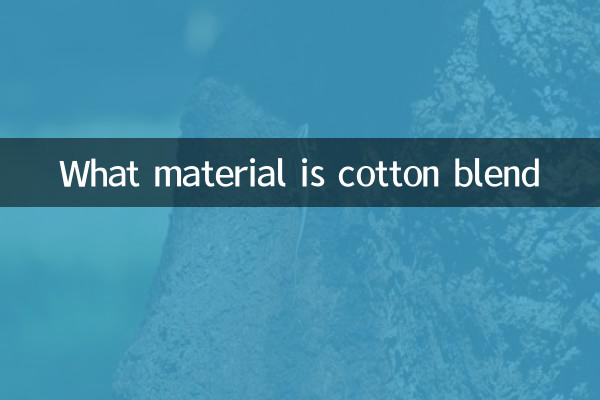What material is cotton blend
In the textile industry, cotton blending is a common fabric that has attracted much attention in recent years due to its unique properties and widespread application. This article will introduce in detail the definition, characteristics, advantages and disadvantages of cotton blends, as well as hot topics and hot content in the past 10 days, to help you fully understand this fabric.
1. Definition of cotton blend

Cotton blending refers to a fabric made by mixing cotton fibers with other fibers (such as polyester fiber, spandex, viscose fiber, etc.) in a certain proportion. This mixing method can combine the advantages of different fibers to improve the overall performance of the fabric.
2. Characteristics of blended cotton
| Features | illustrate |
|---|---|
| Comfort | The moisture absorption and breathability of cotton fibers make the cotton blend fabric comfortable to wear. |
| Durability | After adding synthetic fibers such as polyester fiber, the wear resistance and wrinkle resistance of the fabric are significantly improved. |
| elasticity | After mixing elastic fibers such as spandex, the fabric has better ductility and elasticity. |
| Easy care | Cotton blend fabrics are usually easy to clean and dry and are not easily shrink or deformed. |
3. Advantages and disadvantages of cotton blending
| advantage | shortcoming |
|---|---|
| Combining the advantages of natural and synthetic fibers | Some cotton blend fabrics may not be as soft as pure cotton |
| Price is more economical than pure cotton | Some cotton-blended fabrics are slightly less breathable than pure cotton |
| Widely used, suitable for a variety of clothing types | Environmentally friendly may not be as good as pure natural fibers |
4. Hot topics and hot content in the past 10 days
Through the data monitoring of the entire network for nearly 10 days, we found that the following topics and content related to blending have attracted much attention:
| Hot Topics | Popularity index | Main discussion points |
|---|---|---|
| Comparison between blended cotton and pure cotton | 85 | Comparison of comfort, price and applicable scenarios of the two fabrics |
| Environmentally friendly cotton-blend fabric | 78 | The development of sustainable textile technology and the innovation of environmentally friendly cotton blended |
| 2023 Autumn and Winter Cotton Mixed Fabric Trend | 72 | Designers’ new application and popularity predictions for cotton blend fabrics |
| Nursing tips for cotton blending clothing | 65 | How to properly clean and maintain cotton-blended clothing |
5. Application fields of cotton blending
Due to its excellent performance, cotton blended fabrics are widely used in the following fields:
| Application areas | Specific products | Common blend ratio |
|---|---|---|
| clothing | T-shirts, shirts, dresses, pants | Cotton 65%-polyester 35% |
| Home Textiles | Bed sheets, quilt covers, pillow covers | Cotton 50%-polyester 50% |
| Sportswear | Sports T-shirts, training pants | Cotton 60%-spandex 40% |
6. How to choose high-quality cotton blended products
When purchasing cotton blended products, it is recommended to pay attention to the following points:
1. Check the label ingredients list to understand the specific blending ratio
2. Touch with your hands to feel the softness and thickness of the fabric
3. Check whether the sewing process is fine
4. Understand washing and maintenance requirements
5. Priority selection of well-known brands or products with quality assurance
7. Future development trends
With the advancement of textile technology and changes in consumer demand, cotton blended fabrics will show the following development trends:
1. Higher proportion of environmentally friendly fiber applications
2. Development of functional cotton blended fabrics (such as antibacterial, ultraviolet protection, etc.)
3. The emergence of smart cotton-blend textiles
4. Personalized service with customized blend proportions
In short, as a fabric that combines comfort and practicality, blended cotton occupies an important position in the modern textile industry. By understanding its features and applications, consumers can make smarter buying decisions, while industry practitioners can grasp the direction of future development.

check the details

check the details